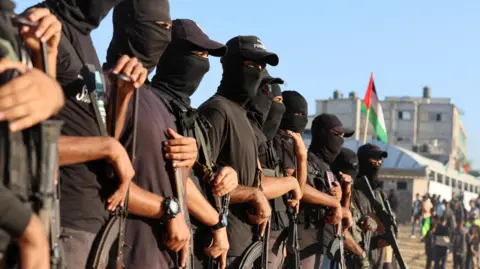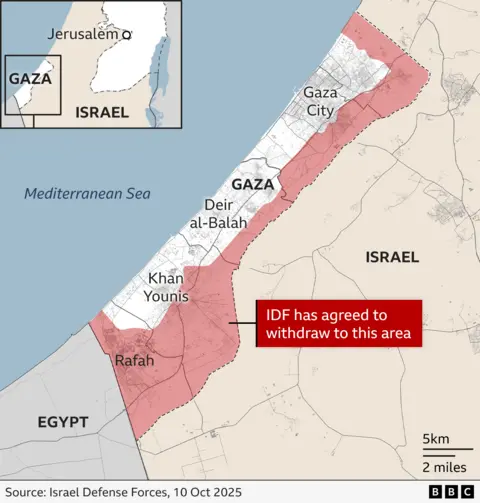 Reuters
ReutersThe leaders of Egypt, Turkey and Qatar have joined US President Donald Trump in signing a commitment to implement his plan to end the two-year war between Israel and Hamas in the Gaza Strip.
It came at the end of a day that saw Hamas hand over all 20 living hostages it was holding in Gaza in exchange for the release of almost 2,000 Palestinian prisoners and detainees held in Israeli jails.
Hamas also handed over the bodies of four deceased hostages. Israel says the remains of 24 others remain in Gaza and must be returned without delay under the ceasefire agreement.
The first phase of Trump’s plan saw the ceasefire come into effect at 12:00 (09:00 GMT) on 10 October and increased amounts of humanitarian aid enter the Strip.
Israeli troops also pulled back to a line that has left them in control of 53% of Gaza – the first of three stages of Israeli withdrawal, according to the Trump plan.
Here’s what we know.
What happens now?
Two elements in the first phase of Trump’s 20-point peace plan remain incomplete – the entry of aid into Gaza without restrictions, including the reopening of the Rafah crossing with Egypt, and the handover of all deceased hostages.
Israel said it received the remains of four hostages on 13 October. However, it has said there are another 24 bodies still in Gaza and the deadline for returning them passed at 12:00 local time (09:00 GMT) the same day.
“We demand that Hamas uphold its part of the agreement,” an Israeli official said, adding the Israeli military “will not rest until all return to their families and to burial in Israel”.
A copy of the ceasefire agreement published by Israeli media last week appeared to acknowledge that Hamas and other Palestinian factions might not be able to locate all of the bodies within that time frame.
An Israeli official meanwhile said an international task force would start work to locate the remains of anyone who was not returned.
Once agreement is reached on the completion of phase one, negotiations over the second phase will begin.
The 20-point plan, which you can read in full here, says that if it is agreed by both sides, the war would “immediately end”.
A multinational force of around 200 troops overseen by the US military will monitor the ceasefire, according to a senior American official, who added no US forces will be on the ground in Gaza.
It also says Gaza will be initially governed by a temporary transitional committee of Palestinian technocrats – supervised by a “Board of Peace” headed and chaired by Trump.
Governance of the Strip would eventually be handed over to the Palestinian Authority – which administers the West Bank – once it has undergone reforms.
According to the plan, Hamas – which seized control of Gaza in 2007 by ousting its rivals, a year after winning legislative elections – would play no future role in its governance, directly or indirectly.
The plan says Gaza will be demilitarised and all “military, terror and offensive infrastructure” will be destroyed.
What are the key sticking points?
There are likely to be multiple points of contention during the negotiations over later phases of the deal.
Hamas has previously refused to lay down its weapons, saying it would only do so once a Palestinian state had been established.
The group also made no mention of disarming in its initial response to Trump’s plan, fuelling speculation that its position had not changed.
And though Israel agreed to Trump’s plan in full, Israeli Prime Minister Benjamin Netanyahu appeared to push back on the Palestinian Authority being involved in a post-war Gaza, even as he stood on the podium next to its president.
Hamas also said it expected to have some future role in Gaza as part of “a unified Palestinian movement”.
Another sticking point is the extent of Israeli troop withdrawal. Israel says its first withdrawal will see it retaining control of around 53% of Gaza. The White House plan indicates further withdrawals to around 40% and then 15%.
That final stage would be a “security perimeter” that would “remain until Gaza is properly secure from any resurgent terror threat”.
The wording here is vague and gives no clear timeline for full Israeli withdrawal – something Hamas is likely to want clarity on.

Who are the released hostages?
The ceasefire deal says Hamas should release all the 48 Israeli and foreign hostages still in Gaza after two years of war.
All but one were among the 251 people abducted during the Palestinian group’s attack on southern Israel on 7 October 2023, during which about 1,200 other people were killed. Israel responded by launching a military campaign in Gaza, during which more than 67,800 people have been killed, according to the territory’s Hamas-run health ministry.
On 13 October, Hamas handed 20 living hostages in two groups to the International Committee of the Red Cross (ICRC).
Israeli authorities said the first group comprised Eitan Mor, Gali Berman, Ziv Berman, Omri Miran, Alon Ohel, Guy Gilboa-Dalal and Matan Angrest.
The second group was made up of Bar Kupershtein, Evyatar David, Yosef-Chaim Ohana, Segev Kalfon, Avinatan Or, Elkana Bohbot, Maxim Herkin, Nimrod Cohen, Matan Zangauker, David Cunio, Eitan Horn, Rom Braslabski and Ariel Cunio.
Hamas said the bodies of four were sent back to Israel on 13 October – those of Guy Illouz, Yossi Sharabi, Bipin Joshi and Daniel Peretz.
The Israeli military said on Tuesday that it had confirmed the identities of the four hostages and named two of them as Guy Illouz and Bipin Joshi.
Who are the Palestinian prisoners and detainees who have been released?
In exchange for the hostages, Israel released 250 Palestinian prisoners serving life sentences in Israeli jails and 1,718 detainees from Gaza.
The list of prisoners published by the Hamas-run Prisoners Media Office did not include high profile figures serving multiple life sentences for deadly attacks on Israelis – including Marwan Barghouti and Ahmad Saadat – whose release Hamas had demanded.
The Palestinian Prisoners’ Society said 88 prisoners were released in the occupied West Bank and East Jerusalem, eight were released in Gaza, and 154 of the prisoners were deported to an unspecified destination.
The ICRC said it had facilitated the return of 1,809 Palestinian detainees to Gaza and the West Bank on 13 October.

